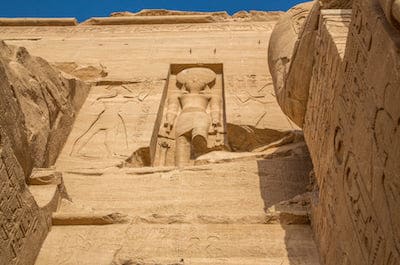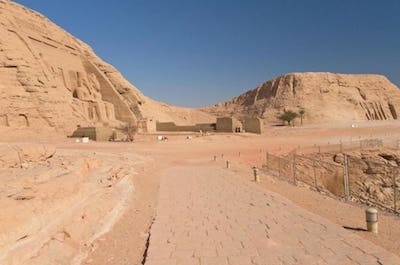No other nation in the world says ‘Welcome’ as often as the Egyptians, and every time, they mean it. While the ancient civilization of Egypt continues to amaze, contemporary Egyptians are equally remarkable.
Activities Essential
Exploring Al Wadi Al Gadid: Essential Activities travel-guide
Rising about 230ft above sea level east of the river Nile stood Qasr Ibrim atop the highest of three cliffs before the Southern Aswan Dam was built. Presently, the site has become mostly an island despite the fact that it is connected to the surrounding area by a land bridge.
The site is visible to tourists only from boats sailing on Lake Nasser as it has been closed to visitors due to its being the last complex on Lake Nasser apart from Abu Simbel. Despite the closure to the public, archaeological work started in 1959, is still being done on the site by the Egypt Exploration Society.
The basic interpretation of the Arabic name Qasr Ibrim can basically be taken as “Fort of Ibrim”. Beyond this simplistic definition, however, the name Ibrim went through various editions before arriving at its present form. Ancient texts give the name as Primis while the Coptics referred to it as Phrim before the Arabs modified it to the word Ibrim.
The actual origin of the site is difficult to trace, but there are speculations that it was constructed by the 12th dynasty kings of the Middle Kingdom who were attempting to take control of the trade route that ran through the river Nile. But based on facts gathered from archaeological studies, 1000 BC is the earliest period from which artefacts were found on this site by which time the Middle Kingdom had come to an end. The strategic location of Qasr Ibrim at an elevated position on the river Nile apparently made it the object of fierce competition and battles by various parties over the course of history and even in recent times.
Consequent upon the rout of Cleopatra and Antony in the battle of Actium in the year 31 BC, Egypt became annexed into the Roman Empire, therefore, an outpost of Roman soldiers was stationed at Aswan. This outpost came under attack from Nubians probably under the leadership of the Queen known as Amanirenas who routed the Romans and controlled, for a period of time, the regions of Aswan, Philae, and Elephantine.
The Romans were able to send in reinforcements however and retook the site, expelling the Nubians to the south and settling at Qasr Ibrim. When Augustus Caeser was the emperor with Gaius Petronius being the local prefect, the Nubians struck once again regaining the location and forcing the Romans to strike a peace deal in which they had to leave the location. Over time, there was a succession of people coming and leaving Qasr Ibrim which meant the location was always occupied up to 1811 when it was completely abandoned.
A stele made during the rule of king Amenhotep I was the first piece of inscription discovered at Qasr Ibrim. The stele is currently in London at the British Museum having been found in the crypt of a Christian Cathedral and its date of creation is estimated to be the eighth year of Amenhotep’s rule.
Apart from the fact that its location is quite desirable for security and physical reasons, Qasr Ibrim also had some religious significance during and after the reign of the Pharaohs. Four shrines, built during the new kingdom by local administrators, are etched into the body of the cliffs in the direction of Aniba (formerly known as Miam, the ancient capital of the region). These shrines were dedicated to the goddess Hathor (whom people in the region considered the goddess of safety and success on voyages), Horus, and the deities of the First Cataract. The shrines eventually had to be relocated due to the risk posed by Lake Nasser’s rising waters.
One of the shrines- the one built by Usersatet, the governor of Kush under Amenhotep II- was rebuilt at the New Nubian Museum in Aswan after being removed from its previous location. There has, yet, not been the rebuilding of any of the other shrines, although new Sabua is being touted as a possible location for the erection of these shrines.
New Kalabsha has also played host to a Stele of Seti I which has been reconstructed at the southern end of the region’s major Ptolemaic temple. At both sides of the plateau of Qasr Ibrim were archaic tombs which have been unfortunately destroyed by the deluge of water from Lake Nasser. Of the surviving religious structures on the site, the earliest is a temple built during the rule of King Tahargo. After the attacks by the Nubians, Qasr Ibrim went through a period of prosperity and affluence during which many temples were constructed while repairs were carried out on King Tahrago’s temple. People with various ailments thronged the temples to seek healing due to the reputation of the temples as places where diseases were cured.
Due to its resilience against invading religions, Qasr Ibrim continued to be a centre of worshipping the traditional Egyptian gods despite the proliferation of Christianity in the surrounding Roman Empire.
Despite the decree to close down the ‘pagan temples’ by Theodosius I (Roman emperor) in 390 AD, the Nubians at Qasr Ibrim stayed adamant and continued to worship in the temples located there. Eventually, they had to capitulate and the Temple of Isis in Qasr Ibrim was demolished while King Tahargo’s temple was converted into a Church for Christians. Another cathedral in honour of the Virgin Mary was erected at Qasr Ibrim in the 7th century using bricks from the ancient temples.
Thus, the area was converted into a Christian region with its own diocese, attracting pilgrims from all over the world who tried to leave a mark of their presence by making impressions of their feet on the site.
The complete tomb of Bishop Timotheos, interred in Qasr Ibrim at the tail end of the 14th century, was found unaltered in the northern crypt of the Virgin Mary Cathedral. Alongside his body were also found his appointment letter written by the Patriarch of Alexandria in 1372 AD.
At the time, Christian burials were done without much ceremony or formalities, the body would simply be covered in a blanket and lowered in a stone-covered grave. However, burials of clergymen were done differently in a more elaborate manner. Bishop Timotheos’ body was found dressed in his official robes as well as the sacred iron cross and some other personal effects. All of these artefacts, discovered in Qasr Ibrim have now been domiciled at the British Museum in London as well as a page from the biblical book of Revelation in the native Nubian tongue and inscribed with Coptic letters.
In accordance with the resistance of Qasr Ibrim to invading religions, Christianity again survived for a long time in the region even when Muslim invaders had promulgated Islam all over the rest of Egypt. It took the conquest of Egypt by the Ottoman Turks and the creation of an outpost of Bosnian mercenaries in the 16th century before Islam successfully replaced Christianity in Qasr Ibrim.
Updated On March 16, 2020



